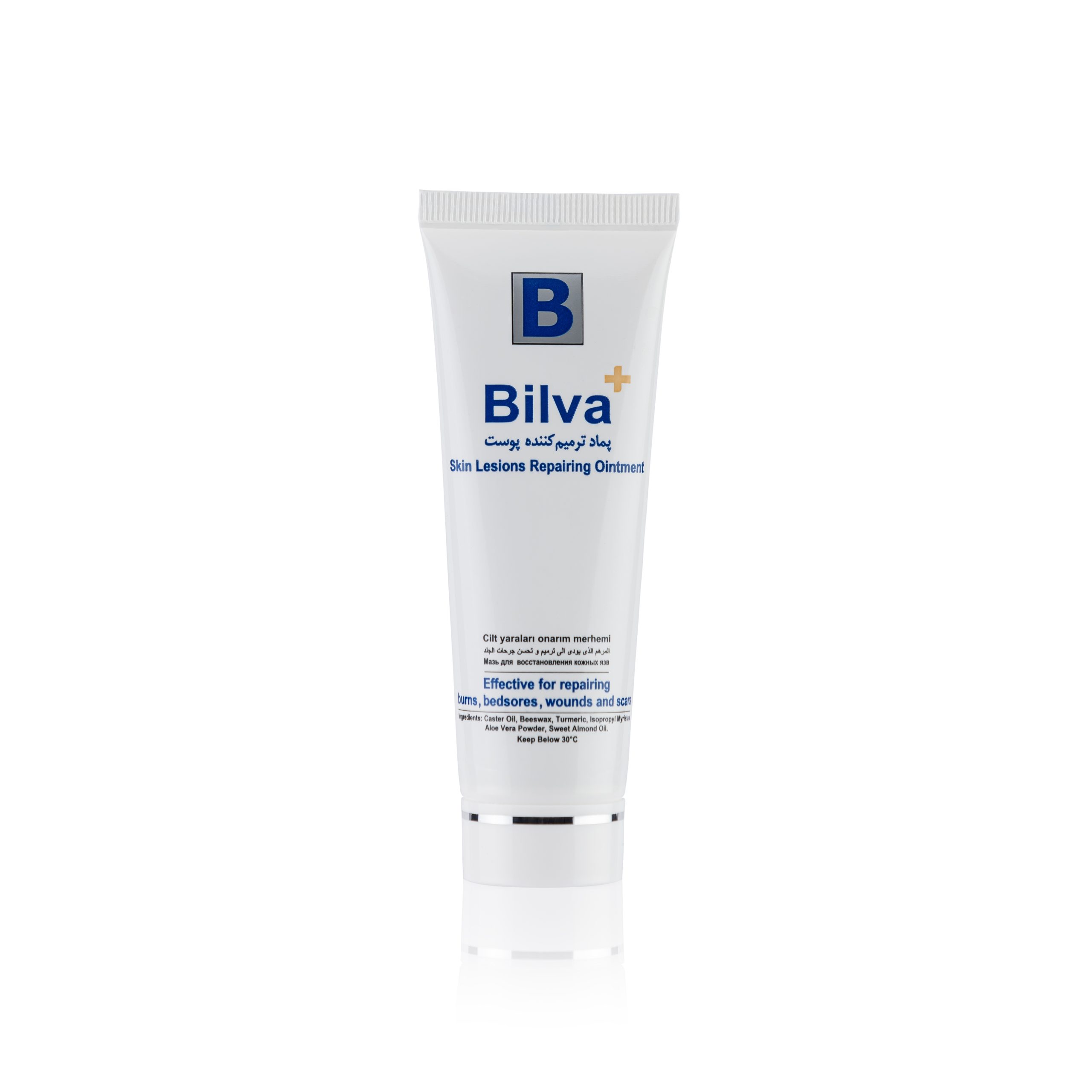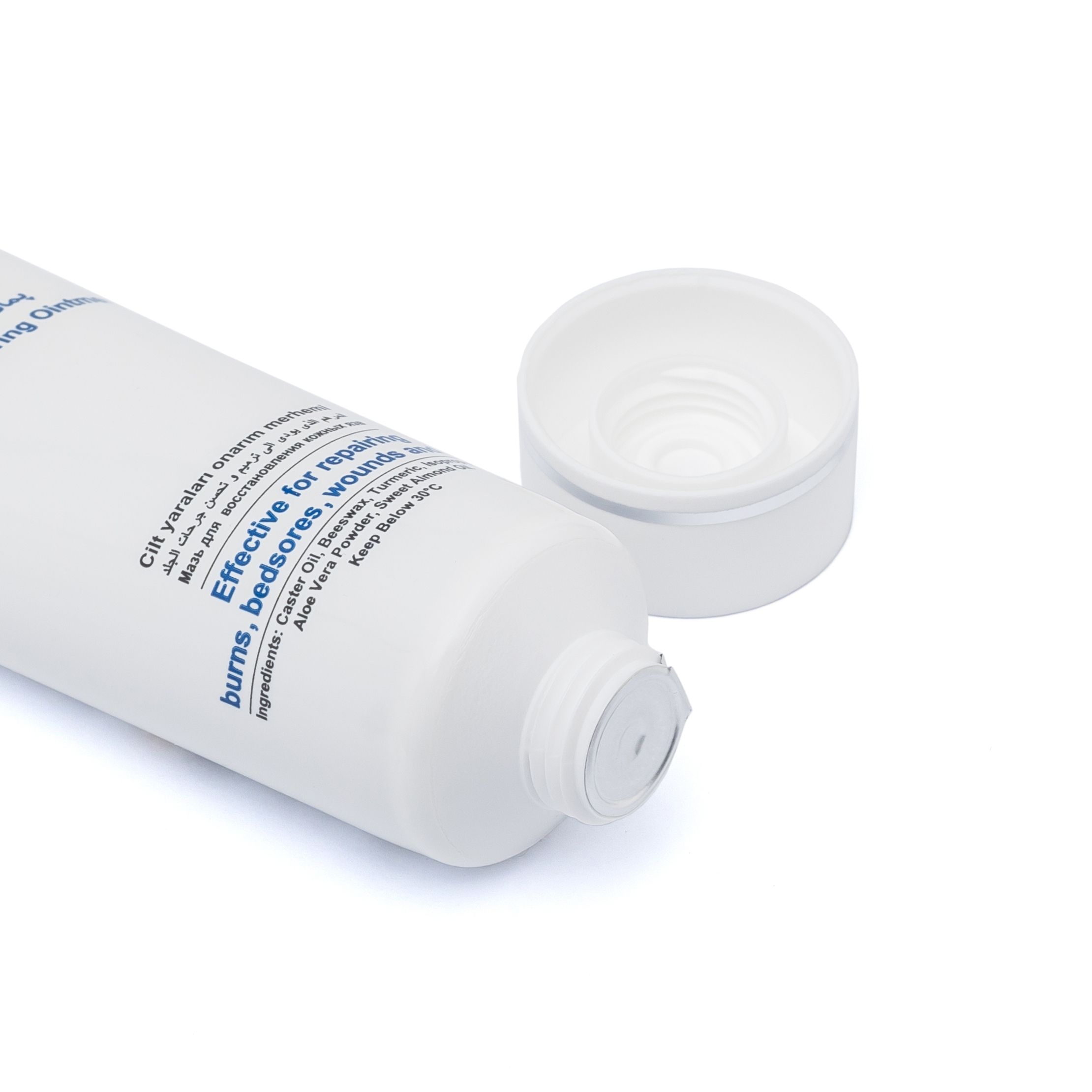


Bilva⁺ Skin repair ointmen
Application of Bilva⁺ ointment: complete skin repair
Various researches have proven its effectiveness in restoration, these effects include increasing the speed and quality of restoration.
By using Bilva⁺, the skin is regenerated naturally and the return of beauty to the skin will be less difficult.
Side effects: The use of Bilva ⁺ ointment has no irritating effect on the skin and no side effects have been reported so far.
Bilva⁺ article link: DOI:10.30491/TM.2022.312344.1392
The effects of the ingredients in Bilva⁺:
Castor oil:
This small plant is herbaceous in cold regions, annual and in tropical regions as a shrub. The most important ingredient of this plant is its oil and its most important fatty acid is ricinoleic acid, which is a saturated hydroxy fatty acid. Due to its softening and healing properties, part of it is used as a skin softener and healer. The antibiotic effect of castor oil against some Gram-positive and negative microbes, including some species of Staphylococcus and Pseudomonas, which are among the most common infectious agents, has also been shown. Castor oil and ricinoleic acid have anti-inflammatory and moisturizing properties and are rich in fatty acids that can provide skin softness and can strengthen the growth of skin tissue and is useful for even skin tone and is non-comedogenic, that is, its fat causes blockage It does not cause skin pores and has antimicrobial properties by helping to remove invading pathogens, contains triglycerides, and also hydrates the skin, and the fatty acids of castor oil cause the disappearance of pregnancy stretch marks, and by producing elastin and collagen, it strengthens the skin. . The fatty acids of castor oil stimulate the lymphatic system and are effective for healing, have cooling properties, and are useful for relieving irritation and redness.
Aloe vera (yellow patience):
It is the best natural way to exfoliate the skin and also helps to reduce the symptoms of skin disease. The use of medicinal plants has been popular in Iran since ancient times. For example, aloe vera is known as a plant for healing and is considered the first plant that helps in healing. Aloe vera plant (yellow patience) is one of the medicinal plants that has been traditionally used since 1500 BC in many countries including Greece, China, Mexico, and has been used locally for skin lesions for centuries. is used. This plant exists in Bandar Sirik of Minab (Hormozgan), Bandar Lange and Bandar Khem in a place called Gazi Castle. The aloe vera plant or yellow patience belongs to the Liliaceae family and looks like a cactus. It is a herbaceous and perennial plant with thick, fleshy and long leaves. It is reported that Egyptian queens regularly used aloe vera in their beauty regimen. It is also mentioned in the Bible that Jesus used yellow patience after He hung on the cross to relieve pain and help in healing. Apparently, Alexander occupied an island from India in 333 BC mainly because of the need for this plant to repair his skin and his soldiers. So far, 75 known compounds have been found in Aloe Vera, including 20 minerals, 20 amino acids. , 12 vitamins and water. In laboratory studies and in studies conducted on living organisms, it has been determined that aloe vera inhibits thromboxane (healing inhibitor) and promotes healing and reduces inflammation. Polysaccharide derived from aloe vera called mannose 6 phosphate causes the active growth of epithelial tissue. This substance connects to fibroblasts and causes them to multiply and eventually causes collagen deposition and tissue reorganization. The gel of this plant contains anti-inflammatory substances such as salicylic acid and thromboxane inhibitors, which prevent the vascular contraction caused by them and works similar to ibuprofen but with a different mechanism. Hydrolysis enzymes such as carboxypeptidase and bradykinase present in aloe vera improve pain and inflammation. The magnesium lactate in the gel prevents the histamine reaction that causes itching and skin irritation. Asemanan 1 substance increases the activity of the immune system and cytokine synthesis. Aloe vera has also been found to be effective against a wide range of bacteria including Pseudomonas aeruginosa, Escherichia coli, Salmonella typhi, Mycobacterium tuberculosis, Klebsiella pneumoniae, Streptococcus pyogenes and Staphylococcus aureus.
Aloe vera plant is one of the restorative plants that is used topically for skin lesions in many countries. Among the plants recommended by Attaran, aloe vera is the only plant that has undergone three forms of laboratory, animal, and human studies, and the overall results of these studies have shown the positive effects of aloe vera gel for healing. Studies show that most herbalists recommend aloe vera as their first herbal medicine of choice. On the other hand, no serious complications have been reported after using the gel; Therefore, this herbal substance is considered safe for topical use.
Turmeric:
Another healing herb is turmeric, which is from the ginger family. The plant is stable and has a height of one to one and a half meters. The basal leaves are without petiole and with distinct sheath which is complete in the upper part. Its flowers are in the form of spikes enclosed in two yellow-green bracts. Swollen and yellow rhizomes with a distinct smell are the main symptoms of the plant. The underground stems of turmeric are called by their scientific name. This plant is native to East Asia and grows in parts of India, China, South, Taiwan, Japan, Indonesia and Africa. Turmeric is yellow pieces 3 to 7 cm long and 1 to 2 cm in diameter, which are used after drying and grinding.
Turmeric has a special place in the traditional medicine of India, China, Japan and Africa. This plant is used in various ways. In the West, it is used as an anti-flatulent and appetite suppressant, and in a study it was shown that turmeric protects the liver of mice and ducks against carbon tetrachloride, acetaminophen and cyclophosphamide toxins. Curcumin and its derivatives present in turmeric have antioxidant effects against radiation. Benefits of turmeric eye drops have also been recorded. The antibacterial activity of the alcoholic extract of turmeric against gram positive bacteria has also been shown in laboratory conditions. Anti-inflammatory effects and immune system stimulation have also been reported from this plant. Another use of turmeric is to help with healing. The curcumin present in turmeric helps to form new blood vessels and increase collagen content and as a result repair, which has been shown in some studies on mice.
Beeswax:
Beeswax is another natural restorative compound that has been widely used recently. Throughout history, among different nations, honey has taken a special place in traditional medicine. Honey from different regions has different nutritional value and healing properties; But clinical and laboratory studies have proven some common properties for honey. Honey has strong antiseptic properties. This property may be due to the osmetic effect and the low and acidic pH of honey. Therefore, honey can also be used for disinfection. If honey is applied topically on damaged skin, it produces hydrogen peroxide, which can have an antiseptic effect. This healing substance is effective in speeding up healing and can also prevent scarring. Honey can also accelerate healing by absorbing the water present in swollen tissues.
Sweet almond oil:
It is useful for relieving skin itching and skin inflammation and skin repair, and it is also useful for repairing skin cracks.
Almond oil is a rich source of vitamin E, protein and minerals.
Isopropyl myristate:
This product acts as a skin enhancer and is used as a moisturizer and is an oil that actually reduces the greasy or greasy feel of some ointments and creams, while absorbing it helps.

